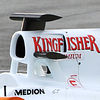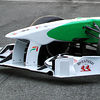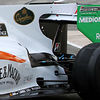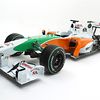James Key happy with smooth design process

Some significant rules changes have made this a busy winter for all the F1 teams, although this year continuity in terms of engine and gearbox supply has been a boost for Force India. Technical director James Key explains some of the thinking behind the VJM03.
Last winter Force India had to deal with a relatively late change of engine supplier and the switch to a McLaren gearbox. How much smoother have things been this time around? It’s obviously been a lot smoother! It’s the first time in a while that we’ve had early confirmation of what the engine is going to be for the next season, and that helps things massively, because a) you’ve got relationships already established with the suppliers, and b) you fundamentally know what to expect. So it helps a great deal, and thus it’s felt a lot smoother this year compared to this time last year.
In 2010 there is no refuelling, the front tyres are narrower, and wheel covers are banned. Have those changes dominated your thoughts, or were there any other key issues? In terms of the way the car was designed and its perfomance, it’s just those three factors. The wheel covers were an aerodynamic device, so you take them off and try and adapt to that, but for the fuel we’ve had to take a lot into consideration, such as the wheelbase and the way the fuel system has to perform without any fresh fuel going in every 20 laps or so. The narrow front tyres have a little bit of an aero implication, but primarily it’s down to what they are going to do, because their characteristics are quite different to last year.
What sort of differences should we look for on the VJM03 compared to last year’s car? It’s a natural progression in areas which seemed to have strong trends at the end of 2009, and in other areas it’s quite different. The back of the car is the area that has evolved most as obviously everyone has had a year of experience with the double diffusers so we’ve all gone into 2010 much wiser to what we can do. There have been some refinements in that area and it’s formed part of the make-up of the car this time around, rather than being added very quickly, as happened at the beginning of last year! It’s natural now to design the car to take these devices. The gearbox is now a little bit easier to work around, and there are tweaks to make the diffuser potential bigger. So there are some notable differences.
What are the implications of the narrower front tyres? As you’d expect with a smaller tyre, it’s less strong. Last year there was a lot of flexibility but I think that will be less this year. You’ve got to get more out of the front tyres, so the cars may be a bit more prone to understeer. Plus the tyres at the back have to support 170kgs of fuel at the start of the race, and you’ve got to look after those as well. So how do you play it? You can’t look after both ends particularly well, so you’ve got to try and make a decision on how you save the rear tyres but you don’t hurt the fronts by doing it. It’s quite a fresh challenge and I suppose you’d say that the driver and the car that can save the tyres best will be at a pretty good advantage compared to cars and drivers that don’t.
How much effort went into calculating the optimum fuel tank size?Potentially if someone gets it wrong, they could be in trouble in high consumption races such as Montreal and Valencia. There was good interaction with Mercedes on what they expected, and we arrived at a size which hopefully is OK! Certainly all the historical data on every track was considered, and we looked at worst case scenarios. We did predictions of what the lap times would be with a lot more fuel in the car, because obviously that affects consumption too. You’ve got the temperature of the fuel to consider as well, because that’s going to increase through the race, so there’s a fuel system implication.
The extra fuel has to go somewhere. To what extent has the chassis grown to accommodate it? In both width and the length directions it’s bigger, because you have got a substantial amount more fuel. I’m sure like every other team we’ve just tried to make the best compromise we can.
What are the implications of the heavy fuel load? The implications on lap time are obviously very big – you are probably talking about up to five seconds. So the cars will certainly go a lot slower at the start of the race. It will be a lot more difficult for the drivers with a heavy load, and certainly our drivers weren’t around in the last era with no refuelling! Then you’ve got your brakes to manage as well. We have our methods of looking at how the brake cooling works, and the targets have been re-set for the fuel loads and energy predictions that we’ve had.
Last year you quickly abandoned the option for an adjustable front flap because incorporating it made it harder to keep up wing development. Will it be more important to have the system operational this year? I think it’s potentially more important. No one really spoke about it much in the paddock last year, we didn’t get the impression it was a big boost for the drivers, so we were happy to do without it. But given that you’ve got the scenario where you’ve got to manage the car in a race now, it’s a good thing to have if you can. So we’re making efforts to ‘future proof’ it this year.
Overall, are you happy with the way everything has turned out? Interestingly, everyone had this massive development rate last year, and those development rates are still going. I think we’ll see a lot of developments this year, certainly in the first half of the season. It was so close at the end of last year, so where should you be this year, where do you pitch it? Are people going to gain a second or three seconds? You’ve got to think very hard about how you play your game this year.







